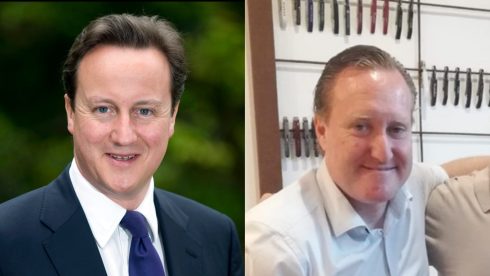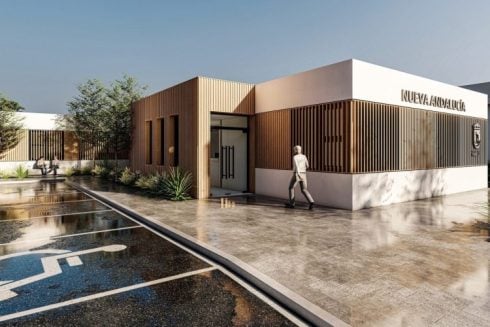IT is easily one of Spain’s most memorable sensations; the moment the adrenaline hits as you look down from a ledge at the top of Ronda’s famous Puente Nuevo bridge.
A staggering 400 foot drop into the abyss of the Tajo gorge below, it is only a series of wrought iron railings that ward off the panic.
A breathtaking geographical feature, this was the location of a haunting chapter in Ernest Hemingway’s seminal novel, For Whom the Bell Tolls, when a line up of soldiers are hurled into the ravine to their death – an event related to actual events during the Civil War.
And Hem, of course, should know… the American literary legend having spent many months in the town, even tipping it as THE best place in the world for a spot of romance.


“It is where you should go if you ever go to Spain on a honeymoon or if you ever bolt with anyone,” he penned in 1932 tome Death in the Afternoon, adding: “The entire town and as far as you can see in any direction is a romantic background…if a honeymoon or an elopement is not a success in Ronda, it would be as well to start for Paris and commence making your own friends.”
He brought various lovers up to the mountain town, just an hour inland from Marbella, including allegedly Hollywood starlet Ava Gardner.
But it was something else altogether that drew him back to the town, time and time again… and that was ‘los toros’.
Bullfighting became one of the main loves of his life and it was on his first trip to Ronda as a young writer exactly a century ago in 1923, that he got his first real taste of the Spanish national pastime.
It came following a ‘boring’ stopover in Sevilla, where he grew tired of constantly hearing flamenco. According to a biographer he kept nagging his travelling companions, a pair of writers, to head up to the town and when he got there he immediately fell for its historic bullring, the world’s first.



Known as the cradle of bullfighting (it was here that Pedro Romero famously jumped off a horse to swipe his cape at a fighting bull) Ronda inspired him to write and he went on to meet various bullfighters, including the legendary Cayetano Ordonez, who later became a model for his most famous book, The Sun Also Rises.
I was equally inspired by the town when I first visited Ronda during a two-year spell working as an English teacher in Madrid in the early 1990s after university.
I was so blown away by its breathtaking scenery and refreshing sierra air that I later booked a two-week stay in its most famous hotel, the Reina Victoria, in an attempt to write a novel, when working as a news reporter at the Daily Mail in London in 1998.
It proved to be a bridge too far, if you’ll excuse the pun, but I truly fell in love with the place and knew I would one day come back to live there.
That came to pass (again, excuse the pun) when my wife and I decided to move to Spain in 2003 soon after our nuptials in the spirit of adventure and to pursue my love of writing and hers of painting.


We ended up buying a run-down farm, planted lots of trees and, before we knew it, we had a couple of children born in the local hospital.
A few years later a new baby was born, that of the Olive Press newspaper and the rest is history, as they say.
What I never did was write a novel, but it inspired me to write two true crime books and, most enjoyably, a restaurant guide, which appropriately picked out a handful of decent eateries in Ronda and its surrounding Serrania.
It also led me to meet and star in one of celebrity chef Gordon Ramsay’s TV programmes in nearby Gaucin, mix it up with Jamie Oliver, when he set a TV series in the town, and even interviewed celebrity chef Jean Christophe Novelli on the famous Tajo bridge.
Planning to move there at the time, he described the sensation of first seeing the views from the bridge as the ‘cono moment’, an actual translation I will leave to your imagination.
The town also blew away BBC TV presenter Nick Knowles, former Prime Minister and now Foreign Secretary David Cameron and US first lady Michelle Obama.

Other famous literary figures who waxed lyrical about Ronda were James Joyce and German poet Rainer Maria Rilke, while Bill Gates came on a secret visit a couple of years ago and Madonna shot her music video, Take a Bow, in Ronda bullring on a windy, wet November day in 1994.
Today, I can think of nowhere in the world I would rather live. The town’s geography never ceases to amaze, its architecture is exquisite, while its range of excellent restaurants and bars is as good as anywhere else in Andalucia, Sevilla and Marbella included.
The local ingredients include amazingly good olive oil, goats cheeses and even some decent pata negra ham, while the nearby countryside is dotted with over two dozen vineyards, the majority improving by the year.
I never tire of a stroll through the old town, admiring its cobbled streets, church spires and beautifully kept family homes (many of them almost mansions). I’ll always find a new angle to take a photo and there are a number of museums and galleries (actually 30 in the town) and, often, interesting exhibitions in the beautiful Antigua Claustro Santo Domingo.
Is it any wonder Ronda is Andalucia’s third most visited place, with millions of day trippers every year. What most of them don’t do is stay the night, which is really to their loss.
The place is at its most charming as the sun sets and the hordes have headed back down to the coast. It is then that the ‘city of dreams’, as poet Rilke christened it, starts to earn its romantic, fairy tale status so promoted by the likes of Hemingway and later, the actor Orson Welles.
Under subtle street lighting, the historic quarter gains a timeless edge, while you can still visit its most alluring buildings, such as the 14th century Mondragon Palace (in part Arabic) until 7pm, or the nearby Santa Maria la Mayor church (which was once a mosque).
It sits on Plaza Duquesa de Parcent, one of the most stunning squares in Spain, particularly with its classical renaissance-style town hall, which was once a military barracks and the still-functioning Santa Isabel Convent on the other side.
For the perfect stroll, head down into the Tajo, reached from either Barrio San Francisco or from a flight of steps down from the Mirador de Maria Auxiliadora.
This is the perfect way to understand the impressive fortifications the town once had during numerous sieges, when the town sat at the western edge of the Kingdom of Granada.
The Moors had a good understanding of this and built a series of walls and arches on both sides of the old town, making it practically impregnable. As you stroll down, you’ll also start to get an understanding of what a feat of architecture the impressive New Bridge was.
It took 42 years to build and for half a century, at 98 metres, it was the highest bridge in the world. Completed in 1793, its fortifications are incredible and have stood the tests of time remarkably well.
At the bottom you’ll get the seminal picture of the bridge and its gorge with its vertical cliff faces, from where rooks soar, often alongside vultures.
From here there are various ways back up, but the best plan is to continue down and take the one-hour circular walk through the Tajo valley, crossing the Guadalevin river, and coming up the other side by the Mirador de los Pinos.
This is the Carretera de los Molinos and nowhere in the world will you get a better appreciation of geography and a sense of place. The various vineyards and ancient farms – some with fortifications going back well over 1,000 years – offer the perfect snapshot of little-changed rural life in southern Spain.
Heading back into Ronda you’ll walk past the famous Reina Victoria hotel, built by English engineers, as they installed the railway line up to Ronda from Algeciras.

As you finally drop back into the centre you’ll most certainly have to take a stroll into the wonderful Alameda park, with its spectacular views, and then the famous bullring next door.
At 243 years old, it is Spain’s oldest and a stunning classical building well worth a visit, with some fabulous original Goya etchings of toreadors at work in one room.
Spain’s most famous bullfight, the ‘Goyesca’, takes place here in September with the matadors and their teams dressing up in 18th century costume paying tribute to the original Goya works.
Look out for the various statues outside, including the local Ordoñez dynasty and Pedro Romero (born 1754) who is dubbed the ‘father of the corrida’.
He killed over 5,000 bulls and passed his skills down the line to the Ordonez’ family who have, so far, provided Spain with three generations of bullfighters… the youngest Cayetano, becoming a handsome Armani model.
Sipping a caña or coffee in the main Plaza del Socorro, or one of the passages off it, it’s not difficult to imagine Hemingway scribbling in the shadows of a backstreet cafe.
His legacy looms large all around the town and he (like Orson Welles whose ashes are scattered at a nearby farm owned by the Ordoñez family) has a small street named after him behind the Parador hotel.
He celebrated his final birthday in Ronda in 1960 and was fittingly, further immortalised with a statue beside the bullring in 2015.
It was from here this Easter, at Semana Santa, that I came across one of the most moving scenes that cemented my own sense of belonging in the City of Dreams.
It was well past midnight and, while my wife and a couple of friends stayed warm in a nearby wine bar, I ventured out to take a picture of the bridge at night.
I thought the parades had long ended, but atop the bridge I found two lines of drummers made up of soldiers from Ronda’s crack local Spanish Legion brigade.
They stood rigid and to attention, dressed in short sleeves despite the cold northerly breeze, staring straight ahead and tapping their drums quietly, rhythmically in perfect unison.
It was hypnotic and insistent and, incredibly, I was one of just half a dozen spectators on the bridge.
After what was easily 15 minutes, out of a side street suddenly loomed a statue of Mary on a float, carried by two dozen other legionnaires. Just behind was another group carrying Jesus, but this time on his side, lying prone.
He was ferried past, legs first facing upwards to the stars above.
I looked up and, as a trumpet started to play, I felt a sense of permanence. The sort that carries you away to the heavens. I knew I was in Ronda for good.









